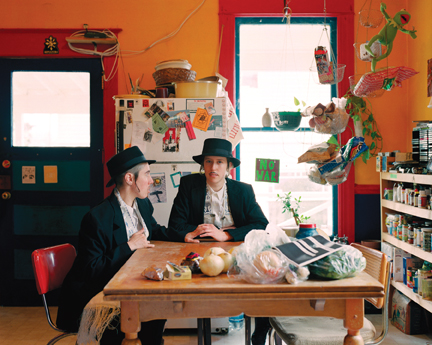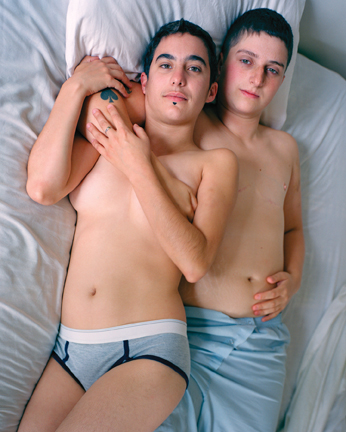IPS gallery, Montreal
November 1 – December 20, 2008
From Barack Obama’s gay-inclusive acceptance speech to the controversial passing of the Prop. 8 ban on gay marriage, the lives of gay Americans are, for better or for worse, on the public radar in the United States. Molly Landreth moves beyond party platforms and ballot boxes, embarking on a tour of the country to produce a growing archive of queer photographic portraits, often working outside of urban gay centres, to provide a distinctive portrayal of what it means, to those who live it, to be queer in America. In this excursion, she revolts against clichéd narratives dictated by policy-makers and mainstream media and permits her lively cast to take charge of their own queer representation. Taking a cue from Robert Frank, entering into dialogues with an unpredictable ensemble both embedded in their environments and breaking free of the stereotyped lives that those environments sometimes inflict, Landreth introduces into the gallery evidence that bright lights, big city, is not always where community – or family – is formed.
Landreth’s large-format prints depict small town made suspect by conceptions of the appropriateness of certain bodies to certain backdrops. “You’re not from around here, are you?” is a euphemistic remark made to those deemed out of place in their surroundings, a passive denunciation of difference, a phrase that sometimes precedes a literal running-out-of-town. Landreth manipulates this exilic custom by choosing as subjects individuals typically made to feel like outsiders in the very places that they call home. Rustic backgrounds situate prodigious subjects as both displaced and firmly planted, her anthropological project extending an affirming hand. “Paying attention to carefully considered identities and surroundings,” she notes, “I find in a moment suspended, that an overlap is revealed, exposing the subtle outlines of who people are and more importantly, who they wish to become.”1
Armed with camera and a candid cross-country community, she is conveniently on hand to witness innumerable unique acts of being and becoming.
In the gallery, queers convene in the backyard and in the kitchen, park themselves proudly on and in cars, and open doors – bedroom and others – that many Americans would rather leave closed. Youthful rites of passage are extended to America’s queer population in the Gregory Crewdson–evoking summer idyll Meg and Renee, Seattle, WA, in which a couple sits cosily in the front seat of an ancient Toyota parked at a lover’s lane – the site of romantic refuge for countless eras of American teens. In Gary and Jeremy, Brooklyn, NY, dreamy repose is on the menu for two post-adolescent boys who sit at a wood-panelled diner table, the arm of Jeremy brought into focus by its doting enveloping of Gary. Straight and queer prejudices are challenged in Ronnie and Jo, a ruminative depiction of two Orthodox Jewish men sitting in a brightly coloured kitchen, fingers intertwined, Jo staring into the camera and Ronnie staring at Jo. A “No War” flier hangs on the window behind, attesting to the political identities of the sitters and complicating uninformed perceptions of the incompatibility of devout religious faith and politically radical identities. In Travis at Gay Skate, Glendale, CA, light-hearted vulnerability and playful awkwardness exude from Travis, who sits off-rink, his hands crossed over his lap, his back hunched in humorous contrast to the reckless confidence that his wheeled footwear requires. Offsetting nuanced representations of queer life are explicit portrayals of queer intimacy, such as Simon and West, 9AM, Seattle, WA, in which two lovers awake to Landreth’s lens, staring unabashedly and directly ahead. Pushing past oversimplified notions of sexual and gender identities, Landreth incorporates into her series the array of bodies that comprise the realities of queer communities and partnerships, compassionately illustrating the untold ways in which they are experienced.
Landreth’s compositional style may be commonplace in photographic practice, but her portraits are nevertheless stimulating, contributing to the body of queer representation that has, arguably, yet to reach its saturation point. Indeed, in a straight world in which queer lives and the bodies that live them are rarely noted for anything other than how they deviate, Embodiment: A Portrait of Queer Life in America enters into the gallery at an opportune moment in American history, a history that, as Landreth makes clear, must stretch to accommodate the heterogeneous population that forms it. While it might still be a while before queer life in America is appreciated in all its diverse manifestations, queer audiences will perhaps be pleased by the prospect of seeing themselves reflected in the images that stare back at them.
Erin Silver is a graduate student in the Department of Art History at Concordia University. Her research is focused on queer aesthetics, collage, and radical exhibition practice.


